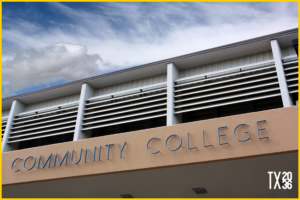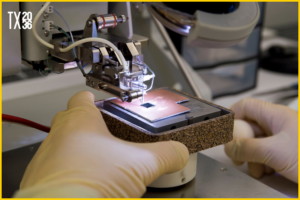The state budget: Tallying the numbers
And down the stretch they come… with lawmakers entering the final weekend, we focus on the session’s one indispensable bill, the budget.
 The Budget
The Budget
House Bill 1 — the general appropriations bill — authorizes the state’s expenditures for the 2024-25 fiscal biennium and is the only constitutionally-mandated legislation that lawmakers must pass.
By the numbers, HB 1 does the following:
- Spends $321.3 billion in all funds.
- The budget commits $17.6 billion toward property tax relief. This represents well over half of the $32.7 billion fund balance going into this session.
- Lawmakers are still hammering out the final parameters of the property tax relief package.
👩🏼🏫 Did you know? Articles II (Health and Human Services) and III (Education) traditionally account for most of the state’s spending in the budget.
 Generational Investments in Texas’ Future
Generational Investments in Texas’ Future
This session, Texas 2036 favored using a once-in-a-generation revenue surplus to make transformational investments into the state’s key infrastructure. The budget reflects that priority in the following ways:
- Broadband internet – $1.5 billion for the proposed Texas Broadband Infrastructure Fund, pending legislative and voter approval. These dollars will be critical as part of the match required for drawdown of broadband dollars through a federal broadband expansion program established by the Infrastructure Investment and Jobs Act (IIJA) of 2021.
- Water – $1 billion for the proposed Texas Water Fund, pending legislative and voter approval, to address aging and deteriorating water infrastructure and to create new water supplies.
- Community colleges – $691 million to help implement community college finance reform, including additional formula funding, grants for regional and statewide workforce needs and additional financial aid.
- Space Commission – $350 million for the Texas Space Commission to provide the workforce, resources and government cooperation necessary to make Texas the center of the rapidly growing space industry.
👩⚕️ Did you know? Texas is not alone in drawing up biennial budgets, but most states pass annual budgets. Lawmakers at times have floated convening budget-only sessions in even years but the proposal hasn’t gained much traction.
 👉 Love this newsletter? Support our work with a donation.
👉 Love this newsletter? Support our work with a donation.
 Investing in Public Education
Investing in Public Education
While the details on the final allocation of public education dollars remain contingent on lawmakers’ decisions in the session’s final hours, here are some spending numbers in the budget.
The topline number here is $5.35 billion in contingency funding for public education funding. This spending is contingent on the passage of multiple bills impacting public education. That breaks down to the following amounts and purposes:
- $4 billion for formula funding increases and teacher pay raises
- $500 million for curriculum
- $500 million for school choice
- $300 million for school safety
- $49.4 million for virtual education
The budget also includes $5 billion for a supplemental 13th check ($1.645B) and a cost-of-living adjustment ($3.355B) for retired teachers.
The supplemental budget bill — separate legislation covering spending needs in the current fiscal biennium — also includes $1.1 billion to award grants to assist school districts in implementing school safety initiatives.
 Better Government Performance by Way of Better Care of State Workers
Better Government Performance by Way of Better Care of State Workers
From the outset of this legislative session, Texas 2036 has signaled strong support for efforts to improve pay and benefits for state workers.
The data shows stagnant state employee compensation is falling behind rapidly rising costs of living, especially in the Austin metro area. For Texas’ 112 state agencies to provide proper levels of support to its customers — the taxpayers — the state must be able to recruit and retain a high-quality workforce.
State government employee pay raises – Budget writers directed $1.8 billion toward an across-the-board pay raise for state employees.
- This investment pays for a 5% increase in annual state employee salaries, with a minimum $3,000 annual increase, in FY 2024, and an additional 5% increase, with a $3,000 minimum annual salary increase, in FY 2025.
The budget also makes further notable increases for other state employees, including:
- $1.95 billion to raise the base wage for home health care workers from $8.11/hour to $10.60/hour.
- Targeted pay raises in critical professional positions where employees routinely leave for private sector or for similar positions at other agencies that offer better pay and/or lifestyle, including:
- Public Utility Commission of Texas attorneys implementing grid reforms
- Texas Commission on Environmental Quality engineers implementing regulations protecting Texans’ health and safety
- Texas Water Development Board financial staff evaluating loan and grant applications, and
- Texas Department of Criminal Justice parole and correctional staff.
 Investing in Over the Horizon Technology
Investing in Over the Horizon Technology
From creating the new Texas Space Commission, as mentioned above, to studying advanced air mobility, from establishing the Texas Semiconductor Innovation Consortium to examining Artificial Intelligence’s role in state government, the Legislature passed a number of bills that reflect the state’s intent to not only participate, but be a leader in existing and emerging technologies.
The budget also reflects these priorities, with investments including:
- $698.3 million for the newly created Texas Semiconductor Innovation Fund to provide matching funding to state entities for semiconductor manufacturing and design projects and to award grants to businesses with an established presence in Texas to encourage economic development related to semiconductor manufacturing and design.
- $440 million for the newly created Texas Institute for Electronics at the University of Texas at Austin, which will research emerging technologies, establish an R&D fabrication facility and other cutting-edge fabrication facilities to support the defense sector and promote the United States’ technological and economic advantages.
- $350 million for the newly created Texas Space Commission to provide the workforce, resources and government cooperation necessary to make Texas the center of the rapidly growing space industry.
- $200 million to the Texas A&M System for quantum and artificial intelligence chip fabrication, plus an additional $26.4 million for the Center for Microdevices and Systems.
ICYMI… Opening the Skies to Flying Vehicles: Lawmakers don’t spend additional funds in the budget on advanced air mobility, but their establishment of an advisory committee on the emerging industry aims to position Texas as a leader in this transformative technology.
 You make the call… where would you spend an extra dollar in the state budget?
You make the call… where would you spend an extra dollar in the state budget?
Tell us! We’ll highlight the best budgetary decision in a future issue!
🧑⚖️ The work of Texas 2036, though, doesn’t end after lawmakers adjourn sine die on the final day of the legislative session. We’ll keep tracking how the decisions made this session impact the lives of everyday Texans.
If you love our work, consider making a donation. 🤝
